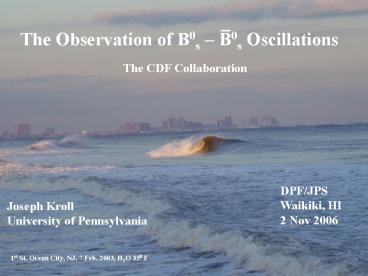The Observation of B0s B0s Oscillations - PowerPoint PPT Presentation
1 / 23
Title:
The Observation of B0s B0s Oscillations
Description:
The Observation of B0s B0s Oscillations. The CDF Collaboration ... Eigenstates of 2-state system (neglecting CP violation) 'Light' (CP-even) 'Heavy' (CP-odd) ... – PowerPoint PPT presentation
Number of Views:35
Avg rating:3.0/5.0
Title: The Observation of B0s B0s Oscillations
1
The Observation of B0s B0s Oscillations
The CDF Collaboration
DPF/JPS Waikiki, HI 2 Nov 2006
Joseph Kroll University of Pennsylvania
1st St. Ocean City, NJ, 7 Feb. 2003, H2O 350 F
2
Northern New Jersey, Saturday, 28 Oct. 2006
photos Alex Riviera see www.localswell.com
3
Todays Results Made Possible by Excellent
Tevatron Performance
Todays results Reported in 2 papers by A.
Abulencia et al. (CDF collaboration)
PRL, 97, 021802 (2006)
hep-ex/0609040, accepted by PRL
see also Parallel session presentations V.
Tiwari (CMU) , J. Miles (MIT)
4
Two-State Quantum Mechanical System
mass width
5
Importance of Neutral B Meson Oscillations
Cabibbo-Kobayashi-Maskawa Matrix
fundamental parameters that must be measured
mass
weak
Oscillation frequencies (?md, ?ms) determine
poorly known Vtd, Vts
see Z. Ligeti Plenary
Vtd/Vts measures one side of Unitary Triangle
New particles in loops alter expectations ? test
Standard EWK Model
SM prediction ?ms 18ps-1
6
Plenary talk J. Shigemitsu
Theoretical uncertainties reduced in ratio
4
PDG 2006
7
Some History
Important prehistory 1983 long B hadron lifetime
2006 APS Panofsky Prize
8
How Do We Measure Oscillation Frequency?
Measure asymmetry A as a function of proper decay
time t
unmixed particle decays as particle
mixed particle decays as antiparticle
For a fixed value of ?ms, data should
yield Amplitude A is 1 _at_ true value of
?ms Amplitude A is 0 otherwise
Amplitude method H-G. Moser, A. Roussarie, NIM
A384 p. 491 (1997)
Units ?m ps-1, 1 then ?m in ps-1.
Multiply by 6.582 10-4 to convert to eV
9
Start 2006 Published Results on ?ms
gt3.4 cycles per lifetime
source http//www.slac.stanford.edu/xorg/hfag/osc
/PDG_2006/index.html
Results from LEP, SLD, CDF I
? ms gt 14.4 ps-1 95 CL
Amplitude
1
0
Average 0.48 0.43
Amplitude _at_ ?ms 15 ps-1
15
Frequency ?ms (ps-1)
10
April 2006 Result from the CDF Collaboration
A. Abulencia et al., Phys. Rev. Lett., 97,
062003 (2006)
Probability that random fluctuations mimic
this signal is 0.2 (3?)
Assuming signal hypothesis measure ?ms
likelihood ratio
Since then goal has been to observe signal with gt
5? significance
11
Ingredients in Measuring Oscillations
Decay mode tags b flavor at decay
opposite-side K
jet charge
2nd B tags production flavor
Proper decay time from displacement (L) and
momentum (p)
Dilution D 1 2w w mistag probability ?
efficiency ?D2 effective tagging power
12
Key Experimental Issues
CDFs strengths
Uncertainty on Amplitude
efficient tracking, displaced track trigger
Signal size
Signal to Background
excellent mass resolution Particle ID TOF, dE/dx
Production flavor Tag performance
lepton id, Kaon id with TOF
Silicon on beampipe (Layer 00)
Proper time Resolution
Fully reconstructed signal crucial
13
Improvements that led to Observation
- Same data set (1 fb-1)
- Proper decay time resolution unchanged
- Signal selection
- Neural network selection for hadronic modes
- add partially reconstructed hadronic decays
- use particle id (TOF, dE/dx) (separate kaons from
pions) - looser kinematic criteria possible due to lower
background - additional trigger selection criteria allowed
- Production Flavor tag
- opposite-side tags combined using neural network
- also added opposite-side kaon tag
- neural network combines kinematics and PID in
same-side K tag
14
Example Fully Reconstructed Signal
Cleanest decay sequence
Add partially reconstructed decays
Also use 6 body modes
Hadronic signal increased from 3600 to 8700
15
Semileptonic Signals
Semileptonic signal increased from 37000 to 61500
16
Decay Time Resolution Hadronic Decays
Maximize sensitivity use candidate
specific decay time resolution
Superior decay time resolution gives
CDF sensitivity at much larger values of ?ms than
previous experiments
17
Semileptonics Correction for Missing Momentum
resolution (fs)
T 2?/?ms
proper decay time (ps)
Reconstructed momentum fraction
18
Same Side Flavor Tags
Charge of K tags flavor of Bs at production
Need particle id TOF Critical (dE/dx too)
Our most powerful flavor tag ?D2 4-5
(Opposite-side tags ?D2 1.8)
19
Results Amplitude Scan
Sensitivity 31.3 ps-1
A/?A 6.1
Hadronic semileptonic decays combined
20
Measured Value of ?ms
Hypothesis of A1 compared to A0
- log(Likelihood)
21
Significance Probability of Fluctuation
Probability of random fluctuation determined from
data
28 of 350 million random trials have L lt -17.26
Probability 8 10-8 (5.4?)
Have exceeded standard threshold to claim
observation
-17.26
22
Asymmetry (Oscillations) in Time Domain
Period 0.35 ps
Aside for B0 Period 12.6 ps
23
Summary of CDF Results on B0s Mixing
A. Abulencia et al., hep-ex/0609040, accepted by
Phys. Rev. Lett.
Observation of Bs Oscillations and precise
measurement of ?ms
Precision 0.7 Probability random fluctuation
mimics signal 810-8
( 2.83 THz, 0.012 eV)
Most precise measurement of Vtd/Vts
20 year quest has come to a conclusion































